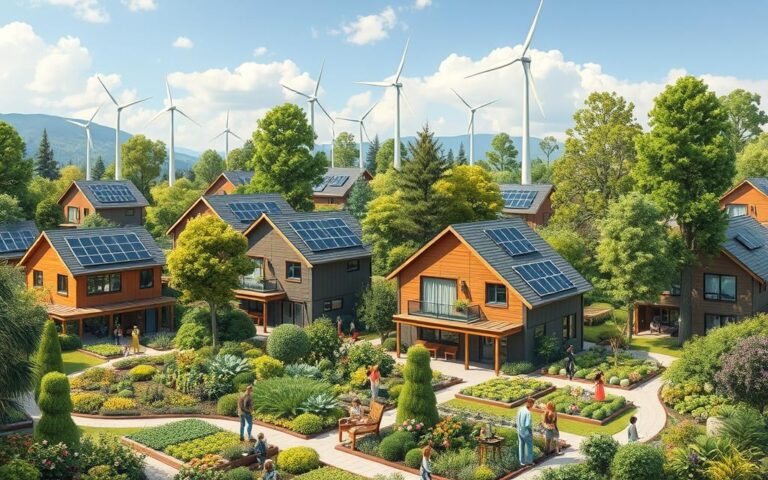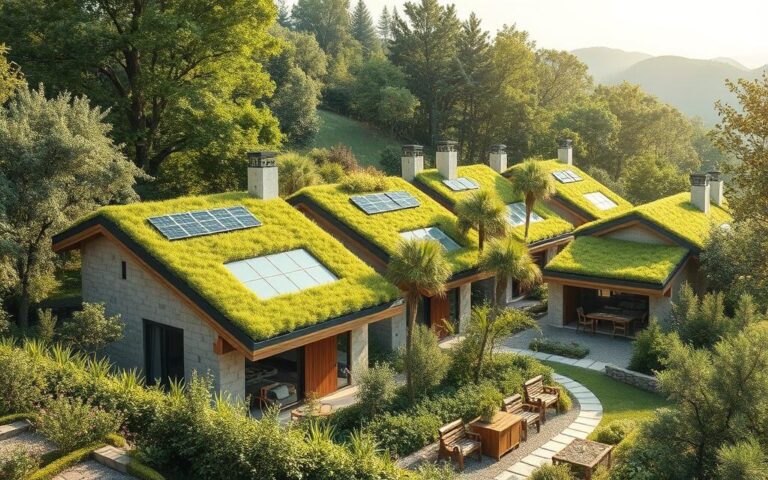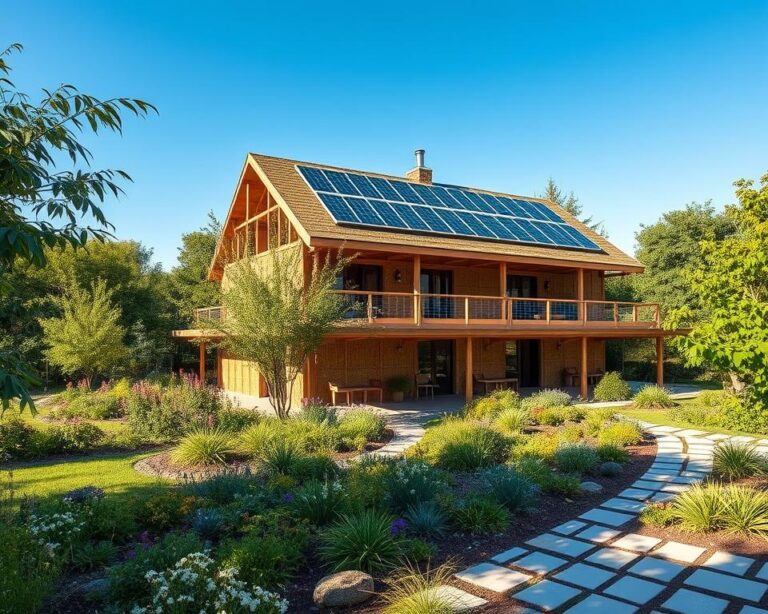Did you know that about 13% of greenhouse gas emissions come from buildings? This is mainly due to heating, cooling, and cooking. It shows we really need sustainable housing in our communities. With climate change, the housing sector is under a lot of pressure to cut its carbon footprint.
Sustainable housing wants to lessen this impact and make homes healthier. It’s a big step towards a better future.
Groups like the National Association of Home Builders (NAHB) know how important green building practices are. They support the ICC 700 2020 National Green Building Standard. This standard helps make homes more energy and water efficient without costing too much.
Most builders are now working to make homes better. They’re using energy-saving and water-saving methods. This shows we’re moving towards eco-friendly homes.

We need new ways to build homes because we’ll need more than ever before by 2050. Using sustainable materials and renewable energy helps solve the housing problem. It also makes homes cheaper to run for the people living in them.
Let’s look at how sustainable housing can make our future greener for all of us.
What is Sustainable Housing?
Sustainable housing means homes built to protect the environment. They use new tech and smart designs to use less energy and cut down on pollution. These homes aim to use green resources and keep nature safe.
As we grow, so does our need for green homes. This is key for our planet’s future.
Defining Sustainable Housing
Sustainable homes blend green design with practicality. Prefab homes are a great example, being both energy-smart and affordable. They’re built fast, unlike regular houses.
Also, tiny homes are small but pack a big punch in reducing carbon emissions. They’re tiny but mighty.
Importance of Sustainability in Construction
Building homes with sustainability in mind saves energy and resources. Earthships, for example, use solar power and collect rainwater. This saves money and protects the environment.
Straw bale homes are another green option. They’re well-insulated, built quickly, and cut down on energy costs.
Shipping container homes are also a smart choice. They reuse old containers, helping our planet. Teaching people about these options can help change minds and encourage more green living.
Plus, programs that help with solar energy can make green homes more appealing. They offer financial benefits for going green.
Benefits of Sustainable Housing
Sustainable housing has many benefits for homeowners and communities. It reduces environmental harm and offers economic gains. These advantages improve personal health and the planet’s health.
Environmental Advantages
Sustainable homes are good for the environment. They use energy-saving methods to cut down on pollution. This includes using materials like sustainable concrete and renewable lumber.
These choices help reduce our impact on the planet. They fight climate change and save natural resources.
Economic Savings
Sustainable housing also saves money. Homeowners in places like Portland see big savings on energy bills. New homes use less energy than old ones.
Old homes might spend $1,700 a year on energy. But new homes spend only about $900. This saves money and can even get tax credits.
Enhanced Quality of Life
Sustainable homes make life better for those who live in them. They have cleaner air, efficient heating and cooling, and green spaces. These features improve health and comfort.
They also support a green lifestyle. This ensures a healthy future for generations to come.
Key Principles of Sustainable Housing
Sustainable housing focuses on energy efficiency, water saving, and eco-friendly materials. These efforts protect the environment and improve the health of those living in these homes. It’s a key part of building for the future.
Energy Efficiency
Energy efficiency is crucial in sustainable homes. Using top-notch insulation and energy-saving systems cuts down on energy use. Homes with a 6 Star rating or higher perform well.
Adding renewable energy sources reduces the need for fossil fuels. This leads to lower costs over time.
Water Conservation
Water saving is another key principle. Using low-flow fixtures and collecting rainwater helps use water wisely. These steps cut down on waste and lower bills.
In areas where water is scarce, these steps are even more important. They help keep water available for the future.
Sustainable Materials
Choosing eco-friendly materials is vital. Builders should use recycled or sustainably sourced materials. This reduces waste and environmental harm.
Using materials that last longer means homes can withstand future challenges. This ensures they meet today’s standards and tomorrow’s needs.
| Principle | Description | Benefits |
|---|---|---|
| Energy Efficiency | Utilization of advanced insulation and energy systems | Lower energy costs and reduced carbon emissions |
| Water Conservation | Installation of low-flow fixtures and rainwater systems | Minimized water usage and reduced utility expenses |
| Sustainable Materials | Use of recycled and sustainably sourced materials | Less waste and lower environmental impact |
Innovative Sustainable Housing Designs
Innovation in sustainable housing is changing the game for living spaces. It focuses on passive house standards and modular homes. Both aim to save energy and reduce harm to the environment.
Passive House Standards
Passive house standards are a new way to make homes energy-efficient. These homes keep a perfect indoor climate without needing heaters or air conditioners. They use a well-insulated building to cut down on energy loss.
This leads to a cozy home that uses much less energy. It’s a big step towards a greener future.
Modular and Prefabricated Homes
Modular homes are a smart, affordable choice for housing. They’re built faster, usually in three months. This is thanks to prefabrication, which also cuts down on waste.
These homes cost less per square foot than traditional ones. They’re also easier to build, helping solve labor shortages in the construction industry.
| Feature | Passive House Standards | Modular Homes |
|---|---|---|
| Energy Efficiency | High efficiency with minimal energy loss | Lower energy consumption due to tightly sealed construction |
| Construction Time | Varies based on design | Approximately three months |
| Cost Per Square Foot | Typical range of approximately $500-600 | Lower than traditional building costs |
| Waste Generation | Minimally wasteful | Significantly less compared to traditional builds |
How to Choose Sustainable Building Materials
Choosing sustainable materials is key to eco-friendly buildings. They protect the environment and improve health. Homeowners and builders have many options, each with its own benefits.
Eco-friendly Material Options
Here are some eco-friendly materials to consider:
- Bamboo: It grows fast, maturing in just 3 to 4 years.
- Reclaimed Lumber: It cuts down on carbon and saves trees from landfills.
- Recycled Steel: It’s strong and saves energy in making.
- Hempcrete: Made from hemp, it’s great for building.
- Cork: From cork oak trees, it’s good for insulation and floors.
- Recycled Plastic: It’s light and used for building blocks and bricks.

Certifications to Look For
Green certifications are important for sustainable materials. Look for these:
- LEED (Leadership in Energy and Environmental Design): Shows products meet high environmental standards.
- National Green Building Standard (NGBS): Makes sure materials are used sustainably.
- OKEO-TEX: Means textiles are safe for indoor air.
- B Corporation and Fair Trade: Supports fair work and wages.
- Climate Neutral Certified: Shows companies aim to reduce carbon.
Choosing materials with green certifications helps the environment and makes homes better.
Understanding Energy Efficiency Ratings
Energy efficiency ratings are key in today’s homes. They help homeowners and buyers understand a home’s energy use. Knowing about the HERS Index and LEED certification can guide choices towards sustainable living.
HERS Index
The Home Energy Rating System (HERS) Index rates a home’s energy use. It was created by the Residential Energy Services Network. A lower score means a home uses less energy, saving money on bills.
Homes with new building techniques, like advanced framing or cool roofs, score better. This leads to less energy use.
LEED Certification
LEED, or Leadership in Energy and Environmental Design, is a big deal in green homes. It checks if a home meets tough green standards. Homes aiming for LEED use solar power, good insulation, and eco-friendly materials.
These homes not only save energy but also attract buyers who want green homes. It’s a win-win for both the environment and the homeowner.
| Rating System | Criteria | Benefits |
|---|---|---|
| HERS Index | Evaluation of a home’s energy efficiency | Lower utility bills, attractiveness to buyers |
| LEED Certification | Environmentally sustainable standards | Enhanced property value, recognition in eco-conscious markets |
The Role of Renewable Energy in Sustainable Housing
Using renewable energy in homes is key to cutting down on fossil fuel use. Solar and wind energy help make homes more sustainable. More people are choosing these options to make their homes energy-efficient.
Solar Energy Solutions
Solar panels are a big help in saving on energy costs. They turn sunlight into electricity, meeting a lot of a home’s needs. They can even cover over half of hot water needs with solar water heaters.
Installing these systems can cost between $5,000 and $21,000. But, homeowners can save money on energy and even sell extra power back to the grid. This is thanks to net metering rules in many states.
Wind Energy Integration
Wind energy is another great way to power homes. Small wind systems can cost between $10,000 and $70,000. They use vertical-axis turbines that work well in cities, supporting green building.
Using both solar and wind energy makes homes more self-sufficient. It also helps meet global sustainable development goals.
Community Impact of Sustainable Housing
Sustainable housing has a big impact on communities. It turns neighborhoods into places that care for the environment and bring people together. By planning sustainable neighborhoods, we make sure there are green spaces, easy walking paths, and good public transport. This helps people live in a way that’s good for the planet.
Creating Sustainable Neighborhoods
Building sustainable neighborhoods means focusing on being strong and welcoming to all. For example, The Vale shows how we can cut down energy use with smart design. It uses insulation and double-glazed windows to make homes better for living in. This also helps the environment.
The World Bank says that “Sustainable Cities and Communities” are key to overcoming today’s challenges. They need to be competitive and resilient.
Engaging Local Communities
Getting local people involved is key to making sustainable housing work. When residents help plan and build projects, they feel more connected. This leads to better living conditions for everyone.
Education and training help people speak up for their needs. Nonprofits are important in this effort. They help bring together residents, governments, and businesses to make a difference.
Tips for Homeowners to Make Their Homes Sustainable
Homeowners can make a big difference in sustainability. They can start with DIY upgrades to make their homes more energy-efficient. These changes save money and help the planet.
Simple DIY Upgrades
Simple changes can make a big impact. Here are some tips for sustainable homes:
- Install Energy Star-rated appliances to boost efficiency.
- Add insulation with a high R-value to improve heat retention.
- Seal drafts to prevent air leakage, contributing to a more energy-efficient space.
- Consider triple-pane windows, which drastically reduce energy loss.
- Utilize LED lighting to minimize electricity use throughout the home.
- Choose locally sourced materials to lessen the carbon footprint associated with transportation.
- Explore reclaimed materials like wood and bricks for renovations.
- Implement drip irrigation systems to save water while maintaining gardens.
Energy Audits and Retrofitting
Getting an energy audit is key to finding areas to improve. Sustainability experts can help. Here are some points to consider:
- Evaluate insulation levels and seek enhancements where necessary.
- Assess windows and doors; ensuring high-performance options can greatly reduce energy expenditure.
- Explore renewable energy options like solar panels to harness clean energy sources.
- Utilize cool roofs to reflect sunlight, thus lowering cooling costs.
- Focus on orientation; maximizing southern exposure can optimize natural light and warmth in colder climates.
| Upgrade | Benefits |
|---|---|
| Energy Star Appliances | Lower energy consumption and utility bills |
| Insulation (High R-value) | Improved temperature control and reduced energy use |
| Draft Sealing | Prevents energy loss and enhances comfort |
| Triple-Pane Windows | Significant reduction in energy expenses |
| LED Lighting | Long lifespan and lower energy bills |
These steps can make your home more sustainable. They save money and help the planet. Moving towards energy-efficient homes benefits everyone and supports a greener future.
Future Trends in Sustainable Housing
Looking ahead, sustainable housing is moving towards smart home technology. This technology helps manage energy use through easy-to-use interfaces. Homeowners can track and improve their energy use easily.
Smart thermostats, energy-saving appliances, and solar systems cut down on bills. They also help make living greener.
Smart Home Technology
There’s also a push for sustainable architecture that fights climate change. Designs like passive solar, green roofs, and using old materials are changing buildings. These designs aim to be durable and use resources wisely.
New projects aim to have less environmental impact. They also try to make housing more affordable.
Advances in Sustainable Architecture
Smart home tech and sustainable architecture are coming together. This creates a more sustainable housing market. Zoning laws are changing to support new building styles.
This means we can build communities that use less energy. They also help keep urban areas beautiful. This change will make eco-friendly homes comfortable and efficient for everyone.
FAQ
What is sustainable housing?
Sustainable housing is about building homes that are good for the planet. It means using energy wisely, saving resources, and creating healthy living spaces.
What are the benefits of sustainable housing?
Sustainable homes are great for the environment. They use less energy and produce fewer emissions. They also save money on bills and offer a better quality of life.
How can homeowners make their homes more sustainable?
Homeowners can make their homes greener with simple steps. They can install water-saving fixtures, add insulation, and switch to LED lights. Doing an energy audit helps find ways to save more.
What materials are considered sustainable for building homes?
Eco-friendly materials for homes include bamboo, reclaimed wood, and recycled steel. Look for certifications like LEED to ensure they’re sustainable.
What is the importance of energy efficiency ratings?
Energy ratings, like the HERS Index and LEED, show how well a home uses energy. They help homeowners and buyers make eco-friendly choices.
How do renewable energy sources contribute to sustainable housing?
Renewable energy, like solar and wind, cuts down on fossil fuel use. It lowers bills and makes homes more independent, making housing more sustainable.
What role does community impact play in sustainable housing?
Sustainable housing builds better neighborhoods. It includes green spaces, walkable areas, and public transport. It also involves local people in planning for a greener future.
What are some future trends in sustainable housing?
The future of sustainable housing includes smart home tech for better energy use. It also means new designs that adapt to climate change, making homes eco-friendly for years to come.




